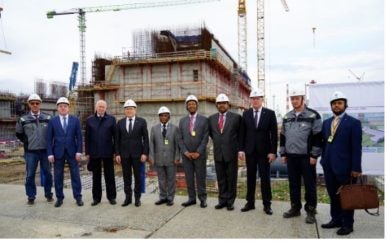
An Indian delegation led by Atomic Energy Commission Chairman Ajit Kumar Mohanty was accompanied on a visit to the Siberian Chemical Combine (SCC) in Seversk in Russia’s Tomsk region by Rosatom Director General Alexey Likhachev. The delegation visited the Brest-OD-300 reactor, which is part of the pilot demonstration power complex (ODEK – Opitno Demonstratsionovo Energo-Kompleksa) being developed under the Breakthrough (Proryv) project intended to demonstrate closed fuel cycle technology.
The ODEK project also includes a module for fabrication and refabrication of nuclear fuel (MFR) and a module for reprocessing irradiated fuel. The reactor is scheduled for grid connection in 2027; the MFR is almost completed and planned for commissioning this year; construction of the reprocessing unit is planned for 2025-2026 for commissioning in 2030.
Likhachev said that India will get next-generation nuclear fuel this summer, describing India as a key partner in the nuclear area. Detailed discussions took place on prospective areas of Russian-Indian nuclear cooperation.
“We are ready for serious expansion of cooperation with India in the field of using nuclear energy for peaceful purposes,” Likhachev noted. “This includes first of all, serial construction of the Russian-designed high-capacity nuclear power units at a new site in India, implementation of land-based and floating low-power generation projects, cooperation in the nuclear fuel cycle area, as well as in the field of non-power applications of nuclear technologies.”
They also visited Tomsk State University and met with regional governor Vladimir Mazur where discussions included potential areas of cooperation, including pharmaceuticals, high technology, education, and research.
Earlier, Indian External Affairs Minister Subrahmanyam Jaishankar said India is looking for additional sites for Russian nuclear reactors. Jaishankar visited Russia in January. Russia is currently assisting with the construction of India’s Kudankulam NPP in the southern state of Tamil Nadu. The plant will comprise six units with VVER-1000 reactors. Work began following an intergovernmental agreement between India and Russia signed in 1988. Units 1&2 (Phase I) are already in operation and work is underway to build units 3-6 (Phases II and III). The customer and operator of the station NPCIL, the general contractor is JSC ASE JSC (Rosatom’s Engineering Division), general designer Atomenergoproject and equipment designer OKB Gidropress.
Units 1&2 began operation in 2016. The general framework agreement with Rosatom on the construction units 3&4 was signed in 2014 and, in 2017, the engineering division of Rosatom and the Nuclear Power Corporation of India Ltd (NPCIL) signed an agreement on the construction units 5&6. Work on units 5&6 began in 2021 and the NPP is expected to be operating at full capacity by 2027. The roadmap for nuclear cooperation between Russia and India provides for the construction of a total 12 units in India, including 4-8 at Kudankulam.
Rosatom also supplies fuel for the plants. Kudankulam plans to switch to using new generation TVS-2M fuel, which will extend the fuel cycle of the reactors from 12 to 18 months. Likhachev said the transition will take place in the summer. In 2022, Rosatom’s fuel company TVEL delivered the first batches of the new TVS-2M nuclear fuel for Kudankulam units 1&2.
“This summer, Indian power plants Kudankulam will switch to a new, innovative fuel. This will not be 12, but 18 months of fuel use, which, of course, gives a completely different efficiency, another project economy, “said Likhachev.






